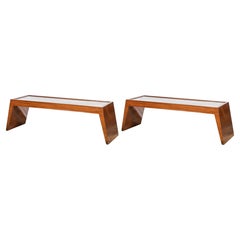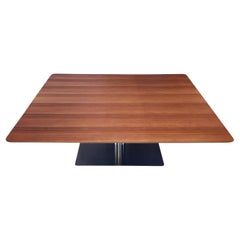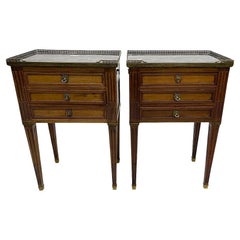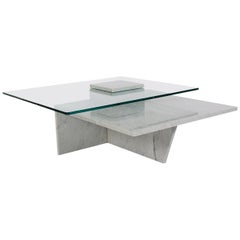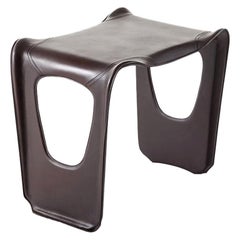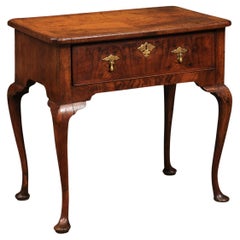Lowboys
1950s Argentine Mid-Century Modern Vintage Lowboys
Glass, Wood
Early 2000s American Mid-Century Modern Lowboys
Stainless Steel
Late 19th Century French Antique Lowboys
Walnut
1990s Italian Post-Modern Lowboys
Marble
2010s Italian Mid-Century Modern Lowboys
Leather, Fiberglass
18th Century English Antique Lowboys
Walnut
Late 20th Century Mexican Country Lowboys
Hardwood
Mid-18th Century English George II Antique Lowboys
Oak, Walnut
1780s British Georgian Antique Lowboys
Oak, Walnut
Early 18th Century European Antique Lowboys
Wood
Late 19th Century French Empire Revival Antique Lowboys
Mahogany
1980s Mexican Country Vintage Lowboys
Cedar
Early 19th Century English Georgian Antique Lowboys
Oak
Early 19th Century English George III Antique Lowboys
Oak
19th Century Antique Lowboys
Oak
1770s English Chippendale Antique Lowboys
Brass
Late 18th Century Northern Irish George III Antique Lowboys
Oak
Mid-18th Century English Queen Anne Antique Lowboys
Oak
1980s Philippine Post-Modern Vintage Lowboys
Stone, Marble
Late 20th Century North American Anglo-Japanese Lowboys
Brass
2010s French Modern Lowboys
Brass, Iron
1960s American Mid-Century Modern Vintage Lowboys
Onyx
19th Century French French Provincial Antique Lowboys
Wood, Hardwood, Sycamore
Early 20th Century British Edwardian Lowboys
Walnut, Burl
Mid-19th Century English Georgian Antique Lowboys
Mahogany
1950s Vintage Lowboys
2010s French Directoire Lowboys
Wood, Cherry
Mid-18th Century British Georgian Antique Lowboys
Brass
1750s English Queen Anne Antique Lowboys
18th Century English Queen Anne Antique Lowboys
Brass
18th Century American Queen Anne Antique Lowboys
Brass
17th Century English William and Mary Antique Lowboys
Brass
1750s English George II Antique Lowboys
Brass
1960s Danish Scandinavian Modern Vintage Lowboys
Teak
1970s American Mid-Century Modern Vintage Lowboys
Glass, Teak
18th Century English Georgian Antique Lowboys
Brass
21st Century and Contemporary British Modern Lowboys
Steel
19th Century French Louis XVI Antique Lowboys
Wood
19th Century Chippendale Antique Lowboys
Brass
1950s American Queen Anne Vintage Lowboys
Wood
Early 19th Century English Georgian Antique Lowboys
Walnut
Mid-18th Century Irish George III Antique Lowboys
Oak
1760s Welsh Georgian Antique Lowboys
Oak
19th Century French Louis XVI Antique Lowboys
Marble
18th Century Antique Lowboys
Oak
2010s French Directoire Lowboys
Brass
20th Century English Campaign Lowboys
Brass
1970s American Mid-Century Modern Vintage Lowboys
Glass, Lucite, Wood
1970s American Mid-Century Modern Vintage Lowboys
Chrome
1970s Italian Post-Modern Vintage Lowboys
Travertine
1740s English Queen Anne Antique Lowboys
Brass
2010s French Directoire Lowboys
Wood, Cherry, Oak, Lacquer
19th Century Georgian Antique Lowboys
Brass
2010s French Directoire Lowboys
Wood, Cherry, Oak, Lacquer
Late 19th Century Italian Country Antique Lowboys
Fir
Mid-18th Century English George II Antique Lowboys
Mahogany
Early 20th Century European Georgian Lowboys
2010s French Directoire Lowboys
Wood, Cherry
18th Century English Georgian Antique Lowboys
Brass
Late 19th Century French Empire Revival Antique Lowboys
Mahogany
Vintage, New and Antique Lowboys
Tables and chests that are low in height are known as lowboys. Vintage, new and antique lowboys are versatile furniture pieces, serving as coffee and cocktail tables, end tables, chests and nightstands.
With their compact size, lowboys can be utilized in entryways, living rooms, dining rooms and studies as well as boudoirs and bathrooms.
A tallboy, on the other hand, might include a wardrobe on top of a set of drawers, while a highboy is usually a simple tall chest of drawers. (If you’re interested in vintage case pieces, we’ve got a guide for that.)
Lowboys became popular as dressing tables in the 18th century in England and America. Chippendale lowboys reflect this heritage, while other antique lowboys have vintage charm. Mid-century modern lowboys often channel the clean lines that we’ve come to associate with furniture in that style.
Lowboys are a design staple because of their adaptability to a variety of spaces. For a project in Portland, Oregon, interior designer Jessica Helgerson featured a Terranova lowboy coffee table among Tudor decor, while designer Charles de Lisle’s California style regularly incorporates cocktail tables and other lowboys as part of a welcoming but sophisticated aesthetic.
Shop 1stDibs for lowboys of all types including chests, consoles, coffee tables and cocktail tables.
